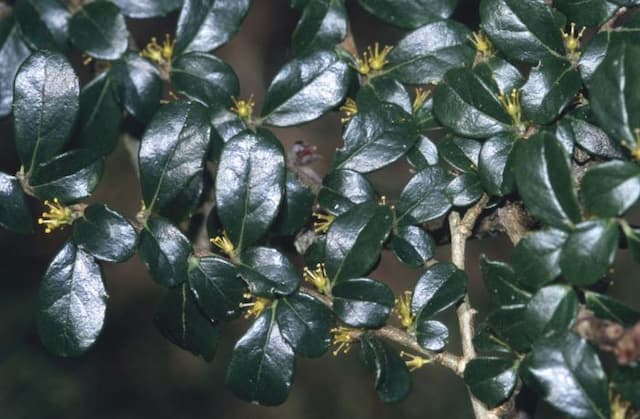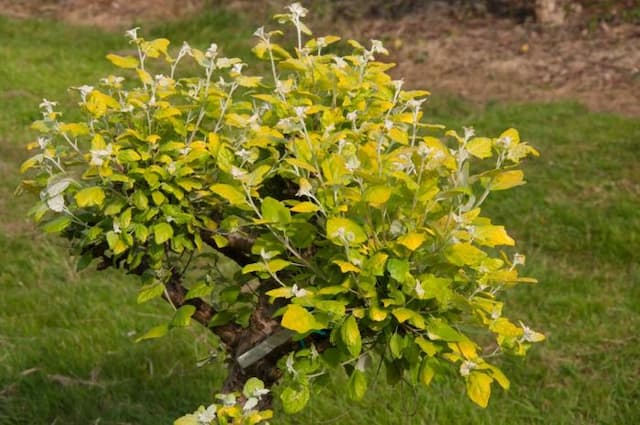White willow Salix alba

ABOUT
Salix alba, commonly known as the white willow, is a type of flowering plant that is often recognized for its elegant and distinctive appearance. It typically displays a spreading canopy that is formed by multiple branches, which adds to its aesthetic appeal. The plant bears narrow, elongated leaves, which are green on the upper side and possess a pale, almost silver-white hue on the underside, giving the species its common name. These leaves are finely toothed along the edges and have a somewhat delicate and fragile appearance. The bark of the white willow is another characteristic feature. It is generally rough and furrowed, displaying a grayish color that can sometimes look whitewashed, contributing to the 'white' aspect of its common name. During the blooming season, the white willow produces catkins, which are cylindrical flower clusters that dangle from the branches. These catkins are often yellowish or silvery and can add a subtle decorative effect to the plant. Throughout the seasons, the white willow's appearance can change. In the spring, the fresh leaves and catkins provide a vibrant look, while in the fall, the leaves may turn yellow before they drop, reflecting the seasonal cycle. The overall impression of the white willow is one of grace and poise, with its cascading branches, striking foliage, and classic bark texture, making it a noticeable plant in any landscape where it grows.
About this plant
 Names
NamesFamily
Salicaceae.
Synonyms
White Willow, European Willow, Silver Willow.
Common names
Salix alba var. vitellina L., Salix alba var. coerulea Sm., Salix alba var. argentea (Borkh.) Sm., Salix alba subsp. vitellina (L.) Arcang., Salix alba var. vitellina (L.) Stokes, Salix alba var. arbuscula Wimm.
 Toxicity
ToxicityTo humans
White willow is not typically considered toxic to humans. It has been used historically for its salicin content, which is a precursor to aspirin, and it is generally considered safe when used in moderation as a natural remedy. However, consuming large amounts of white willow bark might lead to similar side effects as aspirin, such as stomach upset, ulcers, or allergic reactions in people sensitive to aspirin.
To pets
White willow is generally considered to have low toxicity to pets. However, as it contains salicin like aspirin, excessive ingestion may potentially cause similar side effects in pets as in humans, such as gastrointestinal upset or even more serious conditions like ulcers or kidney issues if consumed in large amounts. Monitoring of pets that have ingested white willow is advisable, and a veterinarian should be consulted if adverse reactions are suspected.
 Characteristics
CharacteristicsLife cycle
Perennials
Foliage type
Deciduous
Color of leaves
Green
Flower color
Yellow
Height
50 feet (15 meters)
Spread
35 feet (10.7 meters)
Plant type
Tree
Hardiness zones
2-8
Native area
Europe
Benefits
 General Benefits
General Benefits- Erosion Control: The extensive root system of Salix alba, commonly known as white willow, helps stabilize soil and prevent erosion along riverbanks and wetlands.
- Habitat Creation: White willow provides habitat and nesting sites for various bird species, beneficial insects, and wildlife.
- Windbreaks and Shelter: It can be planted in rows to act as a windbreak, reducing wind speed and providing shelter for crops and wildlife.
- Landscaping and Aesthetic Value: Due to its graceful form and foliage, white willow is often used in parks and gardens for ornamental purposes.
- Construction Material: The wood is light and flexible, making it suitable for various applications, including crates, boxes, and low-grade construction.
- Stream Bank Stabilization: White willow is often used for bioengineering projects aimed at naturalizing and stabilizing stream banks.
- Soil Improvement: Its leaf litter decomposes, contributing organic matter that improves soil structure and fertility.
- Shade and Cooling: The tree provides shade that can reduce local temperatures and create cooler microclimates in urban and rural settings.
- Acoustic Barrier: White willow can help to reduce noise pollution when planted in groups or hedges.
- Carbon Sequestration: Like all trees, it absorbs carbon dioxide, thus contributing to the mitigation of climate change.
 Medical Properties
Medical Properties- Anti-inflammatory: Salix alba contains salicin, which the body converts into salicylic acid, a compound with anti-inflammatory effects.
- Analgesic: It is traditionally used for its pain-relieving properties, especially for conditions such as headaches and muscle pain.
- Antipyretic: The salicin in Salix alba can help reduce fever, a property that has been known since ancient times.
- Rheumatic relief: It may offer relief from joint pain and rheumatic discomfort through its anti-inflammatory action.
- Astringent: The bark has astringent qualities, which can be helpful in treating skin conditions or as part of wound management.
 Air-purifying Qualities
Air-purifying QualitiesThis plant is not specifically known for air purifying qualities.
 Other Uses
Other Uses- As a rooting hormone: The bark of Salix alba contains natural plant hormones that can stimulate root growth in cuttings of other plants.
- In instrument making: The wood is sometimes used to make parts for musical instruments like harps due to its light weight and resonance.
- In environmental management: Its fast growth and tolerance for wet conditions make it useful for stabilizing soils and controlling erosion in riparian zones.
- For livestock fodder: Certain cultivars of Salix alba can be grown specifically as a fodder crop for livestock, particularly in times of drought.
- In basket weaving: The flexible branches of Salix alba make it suitable for crafting baskets and other woven goods.
- As a biodegradable garden tie: Twigs from the plant can be used as natural, biodegradable ties for supporting garden plants.
- In cricket bat manufacture: Salix alba's wood, known as “cricket bat willow,” is traditionally used for making cricket bats.
- As a natural dye: The bark can be used to produce a vegetable dye in shades of brown or black.
- For living structures: Live stakes of willow can be planted and trained to grow into living sculptures or functional structures like garden arbors.
- In artistic charcoal production: The branches can be processed into high-quality artist's charcoal, favored by many for its smooth textures.
Interesting Facts
 Feng Shui
Feng ShuiThe White Willow is not used in Feng Shui practice.
 Zodiac Sign Compitability
Zodiac Sign CompitabilityThe White Willow is not used in astrology practice.
 Plant Symbolism
Plant Symbolism- Flexibility: Salix alba, commonly known as White Willow, is characterized by its slender, flexible branches, which symbolize an ability to adapt and bend without breaking, similar to the willow's capacity to sway with the wind without snapping.
- Healing: White Willow has been used medicinally for centuries, particularly its bark, which contains salicin—a compound with pain-relieving and anti-inflammatory properties. This association has made the tree a symbol of healing and relief.
- Grief: The weeping form of some willow species has led to their association with sorrow and mourning, hence the White Willow can sometimes symbolize grief and the process of dealing with loss.
- Resilience: White Willows are known for their vigorous growth and ability to thrive in different conditions, symbolizing resilience and the ability to overcome challenges and difficulties.
- Wisdom: In various mythologies and folklore, willows are often associated with wisdom and deep knowledge, partly due to their long lifespan and the ancient appearance of their gnarled trunks.
- Protection: The White Willow has been thought to ward off evil spirits in some cultures, and its presence was believed to offer protection, grounding, and the safeguarding of one's home or sanctuary.
 Water
WaterThe White Willow (Salix alba) prefers consistently moist soil and should be watered deeply, especially during dry periods. On average, watering once a week with around 1 to 1.5 gallons of water should suffice, but this may increase to twice a week in periods of extreme heat or drought. Ensure that the planting area allows for proper drainage as the White Willow does not tolerate waterlogged conditions. Adjustments in watering frequency should be made according to rainfall and season, with less water required during the dormant winter months.
 Light
LightThe White Willow thrives best in full sun to partial shade. A spot that receives at least 6 hours of direct sunlight per day is ideal for this plant. Avoid deeply shaded areas as this can impact the tree's growth and overall health.
 Temperature
TemperatureWhite Willow is quite adaptable to temperature fluctuations and can survive in a temperature range from about -30 to 100 degrees Fahrenheit. However, the ideal growing conditions for the White Willow are within 50 to 75 degrees Fahrenheit where it can thrive outside any risk of frost damage or heat stress.
 Pruning
PruningPruning the White Willow is generally done to remove dead or damaged branches, to shape the tree, or to control its size. The best time for pruning is late winter or early spring before new growth starts. Pruning can be done annually or as needed to maintain the desired tree form and health.
 Cleaning
CleaningNot needed
 Soil
SoilThe White Willow thrives in moist, well-drained soils. A mix of loamy soil with sand and compost is suitable for good growth. The ideal soil pH for the White Willow is 6.0 to 7.5.
 Repotting
RepottingWhite Willow trees, being large and fast-growing, are not commonly repotted. They are typically planted directly in the soil where they can spread out without the need for repotting.
 Humidity & Misting
Humidity & MistingWhite Willow plants prefer outdoor conditions where humidity is natural and not controlled. They do not require specific humidity levels when grown outdoors.
 Suitable locations
Suitable locationsIndoor
White Willows are large; indoor cultivation is not practical.
Outdoor
Plant in moist soil with full sun exposure.
Hardiness zone
2-8 USDA
 Life cycle
Life cycleThe common name for Salix alba is White Willow. The life cycle of this plant begins with seed dispersal, typically taking place in spring, where its numerous tiny seeds spread by wind or water. These seeds germinate rapidly in moist soil conditions, initiating the seedling stage where the plant begins to grow its characteristic lance-shaped leaves and flexible stems. The White Willow then enters a vegetative stage, growing rapidly and reaching maturity within a few years, with its sex being determined since willows are dioecious, meaning individuals are either male or female. The mature willow produces flowers in catkins, which, depending on the sex, either produce pollen or develop into seed-bearing capsules after pollination. After years of growth, this perennial can live for several decades, constantly growing and reproducing annually, with the ability to also propagate vegetatively from cuttings or broken branches, which readily form roots in moist soils.
 Propogation
PropogationPropogation time
Early spring
The White Willow, known scientifically as Salix alba, is most commonly propagated through cuttings. This method is popular because it is simple and effective. The best time to take cuttings for propagation is in late winter or early spring, just before the willow begins active growth. A cutting should be about 9 to 10 inches long (23 to 25 centimeters) and contain several buds. The cutting is then planted directly in moist soil or sometimes in water, where it will quickly develop roots. It's important to keep the soil or water moist until the cuttings have rooted well, which can take a few weeks. Once rooting has occurred, the young saplings can be transplanted to their final location.









